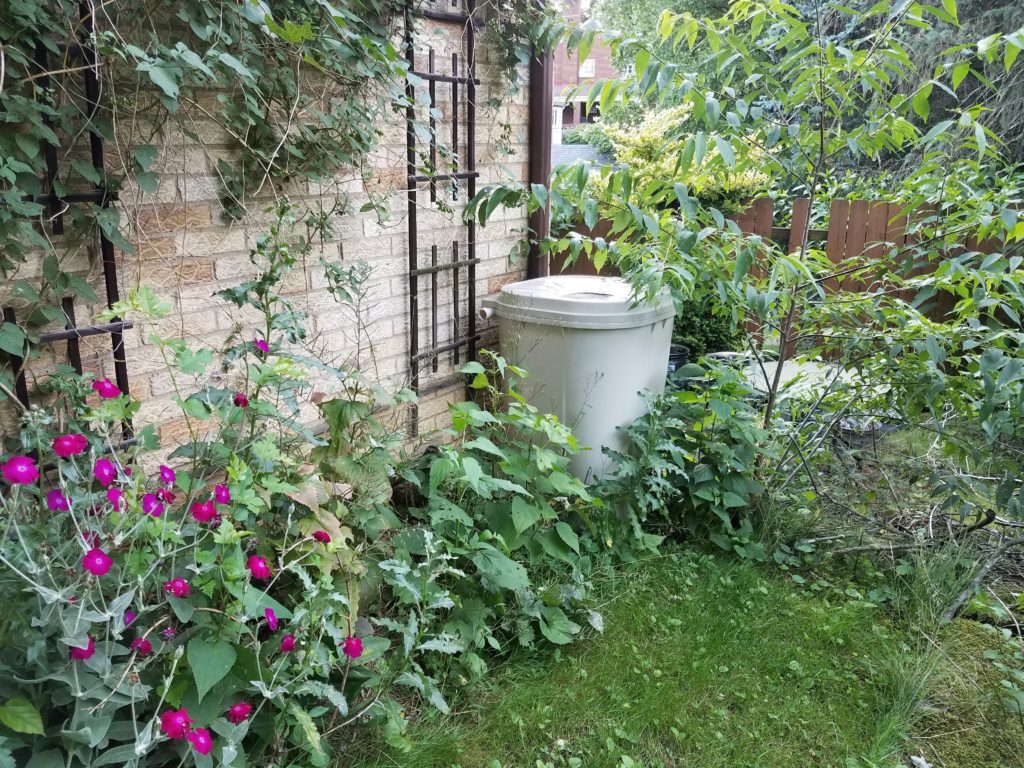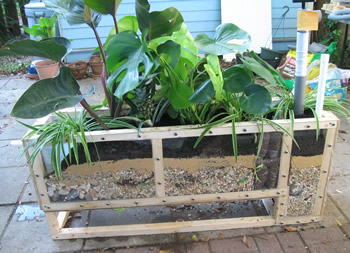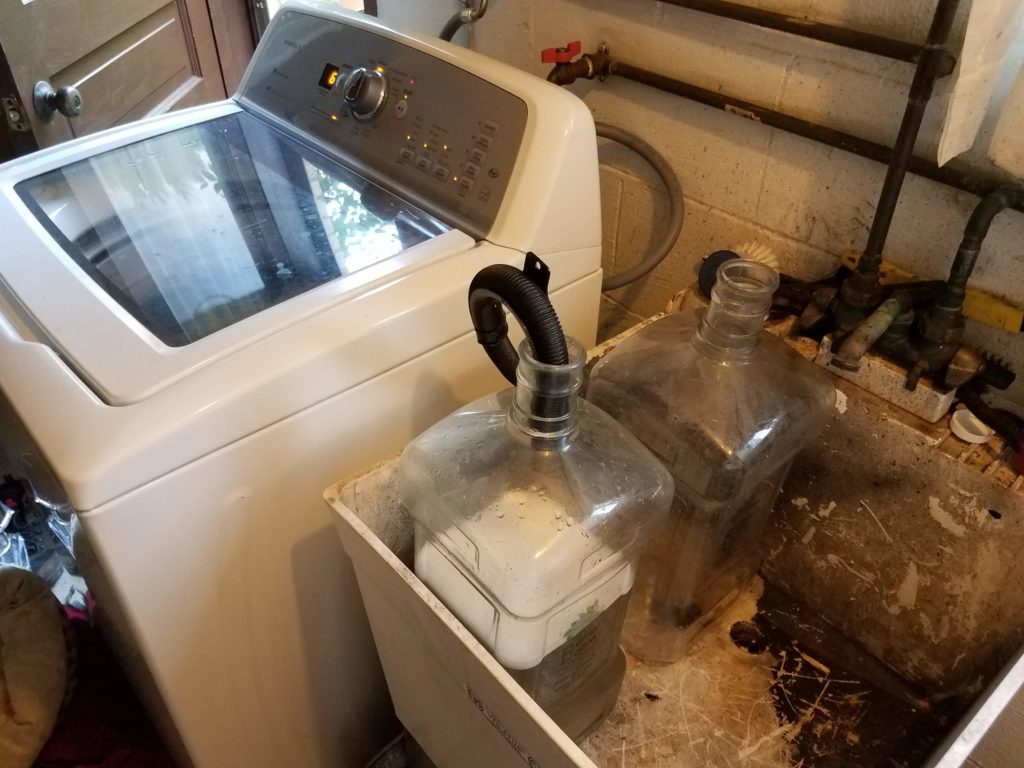Apparently this is the post where I do a lot of name-dropping, which I usually try to avoid. However, I suppose when you have unique organizations doing noteworthy things, it calls for a call-out.
When I moved in with Christian and started to think about landscaping, I knew the one-foot-wide, brick-lined planter off the front of our porch was not going to be sufficient for what I had in mind. I wanted a big, sweeping, wild, pollinator garden with mounds of perennials that bloomed in waves of color from spring to fall. I had a grand design, helped by my on-call gardening consultant: my aunt who, with her significant other, runs Pharo Garden Center.[1] Most of my organic gardening tidbits (and some of my favorite plants) have come from them.
When I started digging up the yard two years ago, I began to realize how huge this garden plan really was, and that it was going to take a massive effort to water everything. Spending most of my disposable income on plants, I really didn’t want to have to spend even more on our water bill to support my gardening habit.
It was around this time that Pennsylvania Resources Council,[2] located on the third floor of my office building, posted their yearly workshop schedule, which included a session on rain barrels. I had already been to their composting workshop and gotten a compost bin for the back yard, so I was thrilled about going to their stormwater management workshop and bringing home a rain barrel.

Unfortunately, Christian and I had differing perspectives on said rain barrel after it came home – that’s a conversation for a different time – and consequently, it sat in our back yard, not hooked up to our downspout, and not collecting rain. I still wanted to use it, even if not in the traditional manner, and I remembered some research I had done in grad school on greywater management.
(My graduate program in sustainable business practices was unique in the Pittsburgh area when I applied, and because I’m still partial to the program and the professors, I’ll just toss a reference in here for Duquesne.[3])
Greywater Reuse
Greywater is wastewater , specifically water that goes down sink and tub drains; nothing from the toilet. Greywater reclamation systems reuse this water for certain applications that don’t need fresh water from the faucet. If I remember correctly, I saw toilets that flushed with recycled greywater when I was in Sweden for a study abroad trip. Often, the greywater is treated or filtered on-site so it’s not as grey, soapy, or chunky (which you can get after washing dishes).
Some home systems I’ve seen involve terraced water plants that do the filtration naturally, rather than using a mechanical filtration system. Organic matter in the water helps to feed the plants at each stage, and the water becomes clearer and more “filtered” at each step. Sometimes fish are even used to consume organic matter, and then their droppings fertilize the plants. It is an interesting topic, one I’d like to research more. I don’t know if we’ll ever build one at home, but that would be many years off.
Since a greywater filtration system was not an option in the short term, I wondered if I could simply transport wastewater from my washing machine outside to the rain barrel and store it there until I needed it for watering plants. It seemed worth a shot.

Biodegradable Laundry Detergent
The laundry detergent I was using at the time was labeled as “eco-friendly,” which is such a ridiculously vague term, I had no idea if it was even safe to put directly on plants without a mechanical filtration step. I knew several people who were making their own detergent, so I decided to try that myself. After all, it couldn’t be bad if I knew what ingredients were going into it, right?
Fortunately for my plants, it didn’t take me long to realize that my homemade detergent contained baking soda, as most of them do. Also, any student of history knows that salt is not good for plants (conquering armies would often sow salt in the fields to make the lands inhabitable), and I quickly determined that I did not want to be putting it on my flowers.
I am still not sure what steps in the treatment process remove sodium-heavy detergents from the water; clearly a call for additional research on my part. I also read that homemade detergents are not great for high-efficiency washing machines, so I used up what I had left, letting that greywater simply go down the drain, and looked for my next options.
As an alternative to my homemade detergent, I found a biodegradable laundry detergent specifically designed for use in greywater systems. It does not contain sodium, and it breaks down into pH-neutral components that actually serve as plant food, making it suitable for greywater reuse without a filtration system. To date, I have not found any other detergents that make these claims.
I was able to buy Oasis[5] online exactly one year before this post, and there is still plenty in the gallon jug. Since it is concentrated, I only use a tiny bit in each load, and it works better than my homemade detergent, which left a bit of a grimy look on my whites. (And yes, I wash everything in cold water.)
As far as harvesting the water, our washing machine empties into a utility sink. I had two three-gallon plastic brewing carboys left over from my very first batches of mead, five years ago. (I now use five-gallon glass carboys, so these two were sitting, collecting dust.) I simply place the drain hose into one of the carboys and let it fill with greywater. Once the first carboy is full, I switch the hose to the second one and take the first out back to the rain barrel.

At first I was worried at first about how much time it would take to watch the machine and transport water out to the back yard, but once I became familiar with the wash cycle, I could easily run downstairs at key times rather than waiting and watching from start to finish.
Depending on the size of the load, I can get about 12 to 15 gallons of water, which is plenty more than I currently need in a week for watering my plants. In fact, on my fourth load of laundry this week, I brimmed out the rain barrel, which started to overflow before I realized I had collected close to 60 gallons of water (for a rain barrel of approximately that size). We had a rainy June, and I was only watering once a week. If past summers are any indication, though, I’ll be watering two or three times a week by August.
It’s a little more effort to transport the water to the rain barrel to store it, and then to fill up the carboys to take them up to the garden to water, but it gives me the warm, fuzzy feeling that comes with being more environmentally conscious, and Christian the warm, fuzzy feeling of having lower water and sewer bills.
Do you have a rain barrel, or do you reuse greywater at your home? I’d love to hear your own stories below.
Thanks for reading!
[1] https://www.pharogardencentre.com/
[3] https://www.duq.edu/academics/schools/business/graduate/mba-programs/mba-sustainable-business-practices
[4] http://www.greennewworld.org/Waste3.html
[5] https://www.bio-pac.com/oasis-biocompatible-cleaners/oasis-biocompatible-super-concentrated-laundry-liquid/
0 Comments